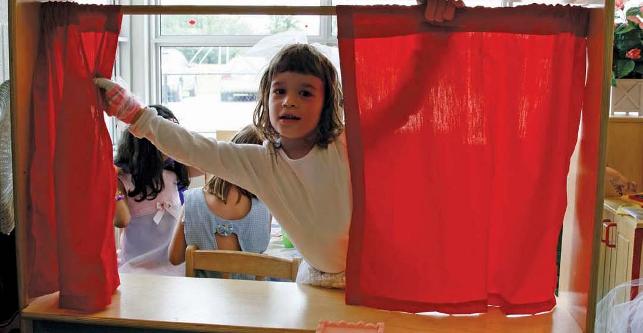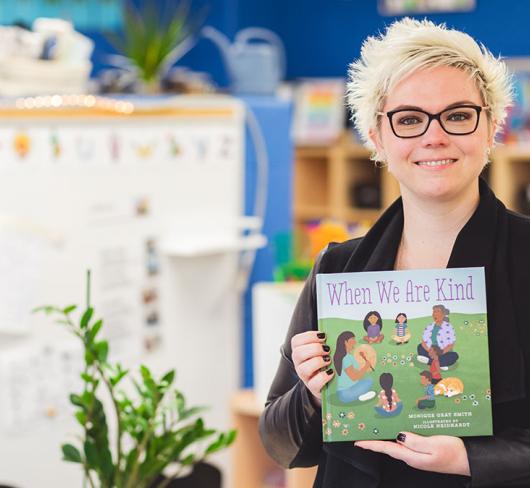
It's Child's Play ...And it Matters!
Teaching children in the early years is a challenge and an opportunity. it can be one of the most rewarding teaching jobs, as very young children experience enormous learning curves. This leap in learning is made possible by allowing children to do something that comes naturally to them – playing with sand, water, and blocks. By setting up an environment in which children manipulate, explore, and experiment with a variety of new materials, the teacher provides them with tools for learning.
The play-based classroom
In a well-planned and adequately equipped play-based setting, children have access to a wide range of learning materials. They can move freely through centres and explore activities that interest them. The class timetable is set up to have at least 60 minutes available for free play each day. Activities are organized so that they are open ended and change over time as children’s skills and interests develop. Different children may take an interest in a centre when its focus changes.
The sand and water tables allow children the opportunity to explore the properties of these materials: how does sand change when water is added, how does water flow through a thin tube or a fat tube? The play changes as props are added or removed. When the water wheel is put away and sea creatures are added to the water centre, the focus changes, sometimes from science to an imaginative narrative; similarly, the children’s vocabulary changes while they are at play.
In the home centre, children act out what they know about family life as they experiment with roles and add to the play by using their imagination. They learn to create narratives, to understand role perspectives, and to develop empathy for characters in their play. In the block centre, children learn proportional reasoning and spatial perspectives as they build towers and towns, and create objects that are significant to them. They develop their vocabulary and grammar as they use oral language skills and share stories; friendships and social skills as they work together and share materials, and foundational skills for mathematics development as they construct. When relevant books and writing materials are added, children have the opportunity to demonstrate their independent knowledge and application of letters and words.
Early childhood is a time when children combine their imaginations and fantasies with personal experiences to think above and beyond normal activities, use their creativity, and strengthen their memory. They demonstrate their personal knowledge and their ability to make sense of the world. As they interact with others, they experience fresh new perspectives and perceive new meanings, and merge these with a background of familiar experiences.
Oral communication is a critical component of play. Children will use and hear others use descriptive and specific vocabulary, which helps them to increase their own vocabulary. Play gives children a chance to communicate with other children and to solve problems. It helps them to understand how social skills rely on effective communication.
Play is the independent work of children
The importance of early child development and its effects on the later stages of life have been clearly demonstrated by research and recognized by major organizations around the world. Children of kindergarten age are still in a critical period of active brain development, which begins to wane after age six. Play is considered to be so important to optimal child development that it has been recognized by the United Nations High Commission for Human Rights as a child’s right. The Association for Childhood Education International (ACEI) recognizes play as being necessary for all children and states that play is critical to optimal growth, learning, and development in children from infancy through adolescence. The absence of play deprives the child of healthy development and learning.
The Early Years Study: Reversing the Real Brain Drain1 provided a great deal of information about children’s early development. Evidence from neuroscience showed that the years from conception to age six, particularly the first three years, build the base for competence and coping skills that affect learning, behaviour and health throughout life. There is also evidence that when children are given opportunities to develop the multiple sensory pathways in their brains by solving problems during play (as compared to completing a single and isolated task), they are laying the foundation for healthy brain development. Children need a variety of different experiences to facilitate this development. As growth is nurtured, the speed of processing, memory, and problem solving is strengthened.
The follow-up study, The Early Years Study 2: Putting Science into Action,2 states that an individual’s capacity to learn is predetermined by the neural wiring that has developed in the earlier years of life. Further evidence shows that the connections that take place within the neurons also affect the ability to attend to lessons, the speed at which information is processed, and the capacity to absorb information. Play provides the educational experience that strengthens and supports the connections between the neurons and provides a rich opportunity for children to grow and develop. Play is essential in the development of cognitive, physical, social, and emotional well-being of children.
The Best Start Expert Panel on Early Learning concludes that in Canada one quarter of children entering grade 1 are vulnerable.3 They have learning, health, and behavioural problems that are likely to interfere with their ability to learn, their ability to form relationships, and their academic success. Early identification of issues and additional support for families and children can assist in reducing these difficulties.
Play is undervalued
Some adults have misconceptions about the importance of play in school and about the goals of the kindergarten pro- gram. Sometimes when adults see a child using school time to play, they believe that little or no learning is taking place. It is easier for them to see results that are measured through marks and scores acquired when children read aloud or do work in their seats.
But it is far more significant for a teacher to observe children as they independently record their learning or their thoughts, read and discuss with a friend a book related to the topic they are exploring, and develop their vocabulary as they interact and share thoughts and ideas with others. These activities demonstrate the child’s application of skills learned independently.
As teachers of kindergarten children, we need to demonstrate to colleagues, administrators, and parents why play is important and what children are actually doing and learning during play. The materials in each centre have been carefully chosen to develop specific skills. The role of the teacher is to facilitate and extend learning, but children need to explore materials at their own level and their own pace. The manipu- latives in the kindergarten classroom should be viewed as the textbooks and science labs of other divisions.
Child’s play? Yes. Frivolous? No. Sand, water, and blocks are the tools that children use to build their learning future.
Notes:
1. McCain M., and Mustard, F. Early Years Study: Reversing the Real Brain Drain (1999), pp. 5-6
2. McCain M., Mustard F. and Shanker S. Early Years Study 2: Putting Science into Action(2007), p. 19
3. Best Start Expert Panel on Early Learning (2006). Early Learning for Every Child Today: A Framework for Ontario’s EarlyChildhood Settings, p. 9

